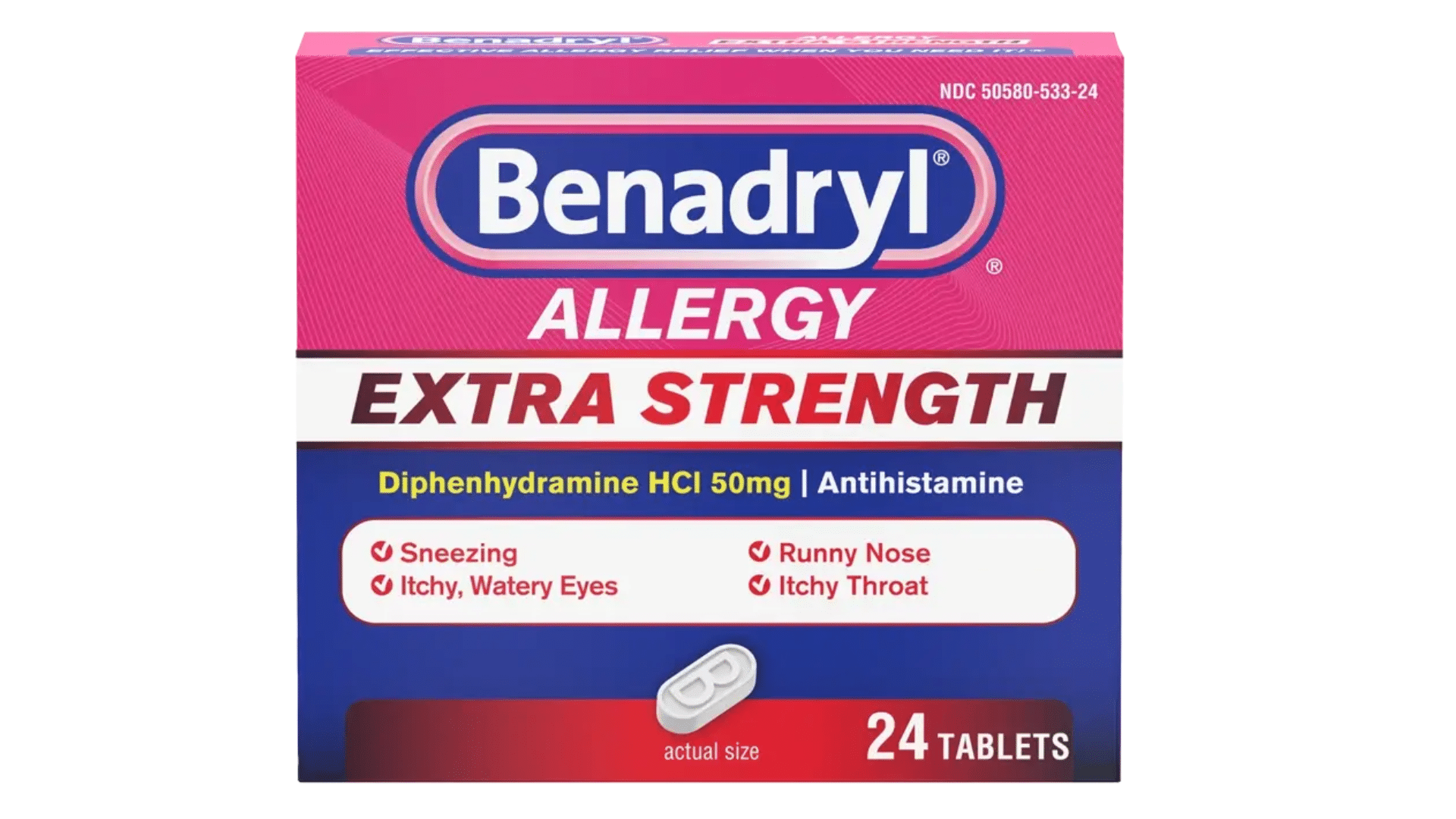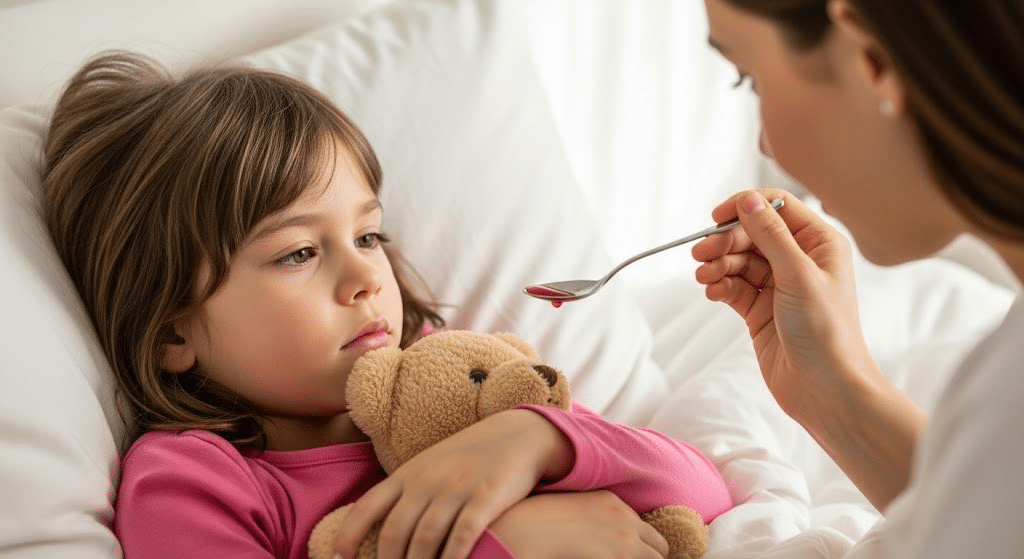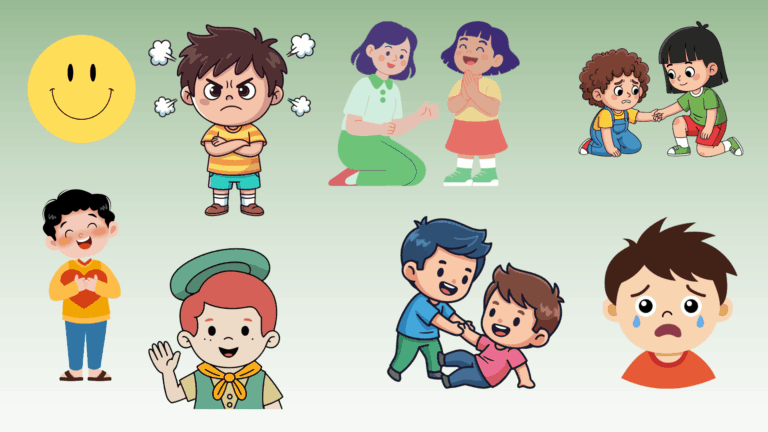Every parent faces sleepless nights when their baby seems uncomfortable or restless. Many wonder if common medications like Benadryl could help their little one sleep better or ease discomfort.
Understanding the safety guidelines and proper dosage for babies is crucial before considering any medication. This information can help parents make informed decisions about their child’s health.
This blog covers can babies have Benadryl, essential safety information about giving Benadryl to babies.
Parents will learn about age restrictions, potential risks, and safer alternatives. It also explains when to consult a pediatrician and what symptoms warrant medical attention.
What is Benadryl Used For?
Benadryl is an antihistamine medication used to relieve symptoms from allergies and colds.
It helps reduce sneezing, a runny nose, itchy or watery eyes, and skin rashes such as hives and itching. It works by blocking histamine, a natural chemical in the body that causes allergy symptoms.
Benadryl is also used to treat itchy skin caused by insect bites, sunburn, scrapes, minor burns, and rashes from poison ivy or oak when applied topically.
Additionally, it can be used for motion sickness, trouble sleeping, and some allergic reactions like anaphylaxis. The drug is available in oral forms like tablets and syrup, as well as topical creams and sprays.
Can Babies Have Benadryl?
Babies under 2 years old generally should not be given Benadryl unless a doctor specifically advises it.
This is because Benadryl (diphenhydramine) can cause serious side effects in infants, such as slowed or difficult breathing, increased heart rate, stomach upset, and even seizures.
Additionally, the medication is not tested thoroughly in babies, so safe dosages are unclear. For children aged 2 to 5, Benadryl should only be given under medical supervision.
It is usually recommended for children 6 years and older. Also, using Benadryl to make a baby sleepy is not safe and may cause the opposite effect, such as agitation or hyperactivity. Always consult a pediatrician before giving Benadryl or any antihistamine to a baby.
Types of Benadryl

Benadryl is a widely used over-the-counter medication primarily known for its antihistamine properties.
It helps relieve allergy symptoms, itching, and cold symptoms. Different types of Benadryl products cater to various needs, including allergy relief, cough suppression, and topical applications.
1. Benadryl Allergy
Benadryl Allergy contains diphenhydramine, a first-generation antihistamine used to relieve symptoms of hay fever, allergies, and the common cold.
It can reduce sneezing, a runny nose, itching, and hives. It is commonly taken orally and may cause drowsiness, which is sometimes used as a sleep aid. Pediatric formulations are available for children’s allergies.
2. Benadryl Cough Syrup
Benadryl Cough Syrup is typically used in countries like Australia and India as a remedy for different types of coughs, including dry, chesty, and tickly coughs.
Its ingredients vary but include diphenhydramine and others like guaifenesin and bromhexine hydrochloride, aimed at soothing the throat and relieving chest congestion.
3. Benadryl Topical Products
Benadryl offers several topical forms, such as creams, gels, sprays, and sticks, designed to reduce pain, itchiness, and irritation on the skin caused by insect bites, hives, or minor injuries.
These topical antihistamines provide localized relief without causing drowsiness.
4. Benadryl for Children
Special formulations of Benadryl Allergy and cough syrups are available for children, typically in liquid forms.
These products are tailored to provide safe and effective relief from allergy or cough symptoms in younger age groups, with appropriate dosing instructions for pediatric use.
5. Benadryl Liqui-Gels and Chewable Tablets
These oral forms of Benadryl provide convenient options for those who prefer not to swallow pills. Liqui-gels and chewable tablets dissolve quickly, offering fast relief from allergy symptoms with the same active ingredient, diphenhydramine. They are popular for their ease of use and quick onset
Benadryl Dosage for Babies: What Parents Must Know

Benadryl (diphenhydramine) is not generally recommended for infants under 2 years old without direct advice from a pediatrician, as it can pose serious health risks. Always consult your doctor before giving any medication to babies and young children.
| Age Range | Weight Range | Type of Benadryl | Recommended Dosage* |
|---|---|---|---|
| Under 2 years | Any weight | Children’s liquid (12.5 mg/5 mL) | Do not use unless directed by doctor |
| 2–5 years | 20–24 lbs (9–11 kg) | Children’s liquid (12.5 mg/5 mL) | 2.5 mL (½ teaspoon) every 4–6 hrs |
| 2–5 years | 25–37 lbs (11–17 kg) | Children’s liquid (12.5 mg/5 mL) | 5 mL (1 teaspoon) every 4–6 hrs |
| 6–11 years | 38–49 lbs (17–22 kg) | Children’s liquid (12.5 mg/5 mL) | 7.5 mL (1½ teaspoons) every 4–6 hrs |
| 6–11 years | 50–99 lbs (22–45 kg) | Children’s liquid (12.5 mg/5 mL) | 10 mL (2 teaspoons) every 4–6 hrs |
Risks and Side Effects of Benadryl in Babies
Benadryl, containing diphenhydramine, is generally not safe for babies, especially those under 2 years old, due to significant risks and side effects.
It should only be used in babies if strictly advised by a doctor and under close supervision. The risks arise because infants react differently to the medication, and improper use can lead to serious health problems.
1. Respiratory Problems
Benadryl can cause slowed or difficult breathing in babies. Infants have delicate respiratory systems, and the medication’s sedative and antihistamine effects may suppress their breathing reflexes.
This can lead to insufficient oxygen intake, posing dangerous health risks such as respiratory distress or failure. Therefore, respiratory monitoring is crucial if Benadryl is administered under medical guidance.
2. Cardiovascular Side Effects
The medication may cause an increased heart rate (tachycardia) or irregular heart rhythms in babies. This effect stresses the immature cardiovascular system, potentially leading to palpitations or more severe heart complications.
Since infants cannot communicate symptoms, caregivers must watch for unusual signs like rapid breathing or paleness and seek urgent care if observed.
3. Neurological Reactions
Benadryl may cause excitability, agitation, or paradoxical hyperactivity in some infants, rather than the expected sedation. In rare cases, seizures have been reported.
These central nervous system effects occur because infants’ brains are more sensitive to this drug. Close observation is necessary, and any unusual movements, confusion, or extreme irritability should prompt immediate medical evaluation.
4. Gastrointestinal Distress
Common side effects include stomach upset, nausea, or diarrhea. Babies’ digestive systems are more vulnerable to disturbances, and these symptoms may lead to dehydration or poor feeding. Continuous vomiting or diarrhea after Benadryl administration requires prompt medical attention to prevent further complications.
5. Risk of Overdose and Toxicity
Accidental overdose can be fatal in infants, causing severe respiratory depression, coma, or death. Due to unclear dosage guidelines for babies under 2, even slight errors can be dangerous. Caregivers must never give Benadryl without precise medical dosing instructions and must store the medicine securely to prevent accidental ingestion.
When to Consult a Pediatrician
You should consult a pediatrician before giving Benadryl to children, especially if they are under 6 years old. The FDA warns against using Benadryl or any antihistamine for children under 2 due to risks like rapid heart rate, breathing problems, or seizures.
For babies under 2 years, Benadryl is generally not advised unless a doctor specifically prescribes it due to serious risks like breathing problems and seizures. If your child is between 2 and 6 years old, it’s important to get medical guidance on the correct dosage and use.
Always seek a doctor’s advice if your child has a history of allergies or asthma, if symptoms worsen, or if you notice side effects like unusual drowsiness, agitation, or breathing difficulties. Consulting a pediatrician ensures safe and appropriate use of Benadryl for your child.
Is Benadryl Dosage for Adults 25 Mg?
The typical adult dosage of Benadryl (diphenhydramine) 25 mg is to take one tablet orally every 4 to 6 hours as needed for allergy relief or cold symptoms such as sneezing and a runny nose.
Adults can take 1 to 2 tablets per dose, but should not exceed 6 doses (300 mg) in 24 hours to avoid adverse effects. This dosing provides effective relief from hay fever, allergic reactions, and itchiness.
For cough relief, the dosage is usually 25 mg every 4 hours, not exceeding 150 mg daily. It is important to follow package instructions or a doctor’s guidance and avoid exceeding the maximum daily limit to prevent side effects like drowsiness, dry mouth, or dizziness.
The Bottom Line
Keeping your baby safe means making informed choices about medications.
Benadryl isn’t recommended for infants under six months, and even older babies need careful dosing under medical supervision.
Remember these key points: always consult your pediatrician first, never guess at dosages, and watch for serious side effects. Natural alternatives like saline drops or a humidifier often work just as well for minor issues.
When in doubt, call your doctor. They know your child’s medical history and can provide personalized advice that’s right for your family.


















